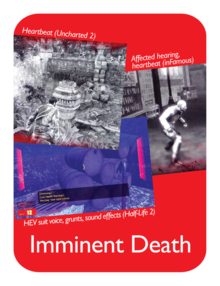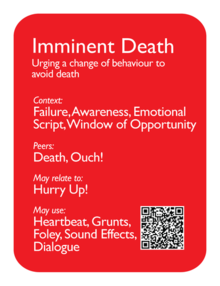Difference between revisions of "Imminent Death"
ValterAlves (Talk | contribs) m |
ValterAlves (Talk | contribs) m |
||
| Line 17: | Line 17: | ||
| rel4=[[Heartbeat]], [[Grunts]], [[Foley]], [[Sound Effects]], [[Dialogue]]<br> | | rel4=[[Heartbeat]], [[Grunts]], [[Foley]], [[Sound Effects]], [[Dialogue]]<br> | ||
| revisions =Introduced in version 1.0 | | revisions =Introduced in version 1.0 | ||
| + | | description= | ||
| + | Many games implement death through decrements in health as a result of repeated injury. Recovery may depend on self-administering some kind of remedy and/or spending time enough without taking damage. Moreover, recovery often comes at a cost, so it is inevitable to manage some level of injury. The problem is that players may lack the [[Awareness]] for imminence of [[Death]] and unwittingly (and avoidably) let the PC die. | ||
| + | |||
| + | Providing clear indicators of [[Imminent Death]] promotes [[Awareness]] for the need to adopt a behaviour that reverses the evolution towards [[Death]]. Furthermore, both health and death are concepts with profound semantics and prominent association to emotions and values. That, at least, calls for a meaningful signaling. | ||
| + | |||
| + | [[Imminent Death]] is particularly relevant in the heat of an [[Engagement]] when the player may be deeply focused in other aspects of the conflict – timing, moves, tool selection, etc. – and attention is diverted from less evident health indicators. | ||
| + | |||
| + | Diegetic interpretations of [[Imminent Death]] are effective because they allow a more direct understanding of the situation and they avoid the need to be attentive to some health monitor. | ||
| + | |||
| examples= | | examples= | ||
| ex1=<mt p="ImminentDeath" g="Uncharted 2" w="{{R16by9W}}" h="{{R16by9H}}"></mt> | | ex1=<mt p="ImminentDeath" g="Uncharted 2" w="{{R16by9W}}" h="{{R16by9H}}"></mt> | ||
Revision as of 15:03, 13 October 2011

|

| |
| The card's front face | The card's back face |
Contents
Synopsis
| Urging a change of behaviour to avoid death. |
Relationships
context:
Failure ![]() , Awareness
, Awareness ![]() , Emotional Script
, Emotional Script ![]() , Window of Opportunity
, Window of Opportunity ![]() .
.
Peers:
Death ![]() , Ouch!
, Ouch! ![]() .
.
May relate to:
Hurry Up! ![]() .
.
May use:
Heartbeat ![]() , Grunts
, Grunts ![]() , Foley
, Foley ![]() , Sound Effects
, Sound Effects ![]() , Dialogue
, Dialogue ![]() .
.
Description
Many games implement death through decrements in health as a result of repeated injury. Recovery may depend on self-administering some kind of remedy and/or spending time enough without taking damage. Moreover, recovery often comes at a cost, so it is inevitable to manage some level of injury. The problem is that players may lack the Awareness for imminence of Death and unwittingly (and avoidably) let the PC die.
Providing clear indicators of Imminent Death promotes Awareness for the need to adopt a behaviour that reverses the evolution towards Death. Furthermore, both health and death are concepts with profound semantics and prominent association to emotions and values. That, at least, calls for a meaningful signaling.
Imminent Death is particularly relevant in the heat of an Engagement when the player may be deeply focused in other aspects of the conflict – timing, moves, tool selection, etc. – and attention is diverted from less evident health indicators.
Diegetic interpretations of Imminent Death are effective because they allow a more direct understanding of the situation and they avoid the need to be attentive to some health monitor.





